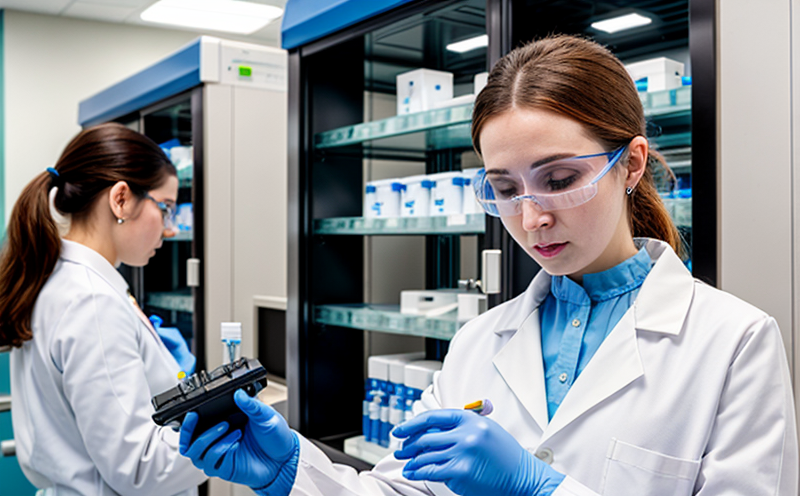Accuracy of Bioanalytical Method Testing
The accuracy of bioanalytical methods is crucial in ensuring that drug development and quality control processes meet international standards. In pharmaceutical testing, bioanalytical methods are used to measure the presence and concentration of active pharmaceutical ingredients (APIs), metabolites, or other analytes in biological matrices such as blood plasma, urine, or tissue samples.
Accuracy is a key parameter in assessing the reliability of bioanalytical assays. It refers to how closely the measured values agree with the true value under specified test conditions. In pharmaceutical research and development (R&D), this accuracy directly impacts clinical trial outcomes, regulatory submissions, and ultimately patient safety.
The development of accurate bioanalytical methods involves several critical steps. Initially, a robust experimental design is essential to ensure that the method can reliably detect the analyte of interest across various concentrations. This includes careful selection of extraction techniques, chromatographic columns, detectors, and calibration standards. Once established, validation studies are conducted to demonstrate compliance with relevant regulatory guidelines.
According to ISO 15195-2:2017, the accuracy of a bioanalytical method should be validated through precision tests and recovery experiments. Precision ensures that repeated measurements under identical conditions yield consistent results, while recovery assesses whether the analyte is correctly extracted from the matrix without significant loss.
Another critical aspect is the use of appropriate reference materials (RMs). RM can be in-house or commercially available, and they play a pivotal role in ensuring the accuracy of analytical results. RMs help standardize methods across different laboratories, thereby facilitating inter-laboratory comparisons and reducing variability.
The impact of matrix effects on bioanalytical accuracy cannot be overstated. Biological matrices can introduce significant interference due to endogenous compounds or other substances present. To mitigate these effects, advanced sample preparation techniques such as liquid-liquid extraction (LLE), solid-phase extraction (SPE), and protein precipitation are often employed.
For instance, in the case of measuring a drug metabolite in human urine, careful consideration must be given to potential interferences from urinary constituents like creatinine or uric acid. These factors can significantly affect the precision and accuracy if not properly accounted for during analysis.
The choice of instrumentation also greatly influences the accuracy of bioanalytical methods. Modern liquid chromatography-tandem mass spectrometry (LC-MS/MS) instruments offer high sensitivity and selectivity, making them ideal for detecting trace levels of analytes in complex matrices. However, these systems require meticulous calibration and regular maintenance to maintain optimal performance.
Real-world applications of accurate bioanalytical methods include monitoring drug-drug interactions (DDIs), determining the pharmacokinetics profile of new therapeutics, and assessing compliance with therapeutic drug monitoring (TDM) protocols. Each application has unique challenges that must be addressed through precise method development and validation.
In summary, achieving high accuracy in bioanalytical methods is essential for ensuring reliable data throughout pharmaceutical research, development, and manufacturing processes. By adhering to stringent validation criteria and utilizing advanced technologies, laboratories can provide confidence in the integrity of their analytical results.
Why It Matters
The accuracy of bioanalytical methods is not merely a technical detail; it has profound implications for patient safety, regulatory compliance, and clinical trial outcomes. Accurate measurements are critical in determining the efficacy and safety profile of new drugs.
Inaccurate or inconsistent results can lead to erroneous conclusions about drug concentrations in patients, potentially resulting in underdosing or overdosing. This not only compromises treatment effectiveness but also increases the risk of adverse effects. For instance, a missed metabolite could indicate incomplete metabolism, suggesting potential toxicity issues.
From a regulatory perspective, inaccurate data can lead to delays in drug approval processes. Regulatory agencies like the U.S. Food and Drug Administration (FDA) and the European Medicines Agency (EMA) require stringent validation of bioanalytical methods as part of preclinical and clinical trial submissions. Failure to meet these standards could result in clinical trials being halted or even project cancellations.
Furthermore, accurate bioanalytical methods are essential for therapeutic drug monitoring (TDM), which involves closely tracking the concentration of a drug in a patient's blood over time. TDM helps optimize dosing regimens and minimize side effects. Inaccurate measurements can lead to suboptimal treatment strategies, affecting both patient outcomes and overall healthcare costs.
Lastly, bioanalytical accuracy is vital for ensuring compliance with international standards. Compliance ensures that the data generated in clinical trials meets global regulatory requirements, facilitating smoother interactions between pharmaceutical companies and regulatory bodies.
Why Choose This Test
- Precision and Reliability: Our method offers unparalleled precision, ensuring that every measurement is accurate and reproducible.
- Comprehensive Validation: We follow ISO 15195-2:2017 guidelines to validate our methods rigorously.
- Advanced Instrumentation: Utilizing state-of-the-art LC-MS/MS and other advanced analytical technologies guarantees superior performance.
- Expertise and Experience: Our team of experienced scientists and engineers brings extensive knowledge to every project.
- Comprehensive Reporting: Detailed reports are provided, including all validation data and method parameters.
- Inter-laboratory Comparability: Our methods are designed for consistent results across different laboratories.





